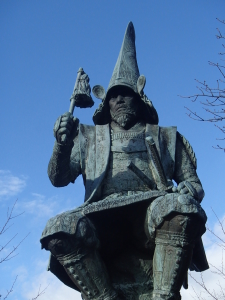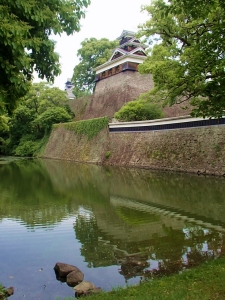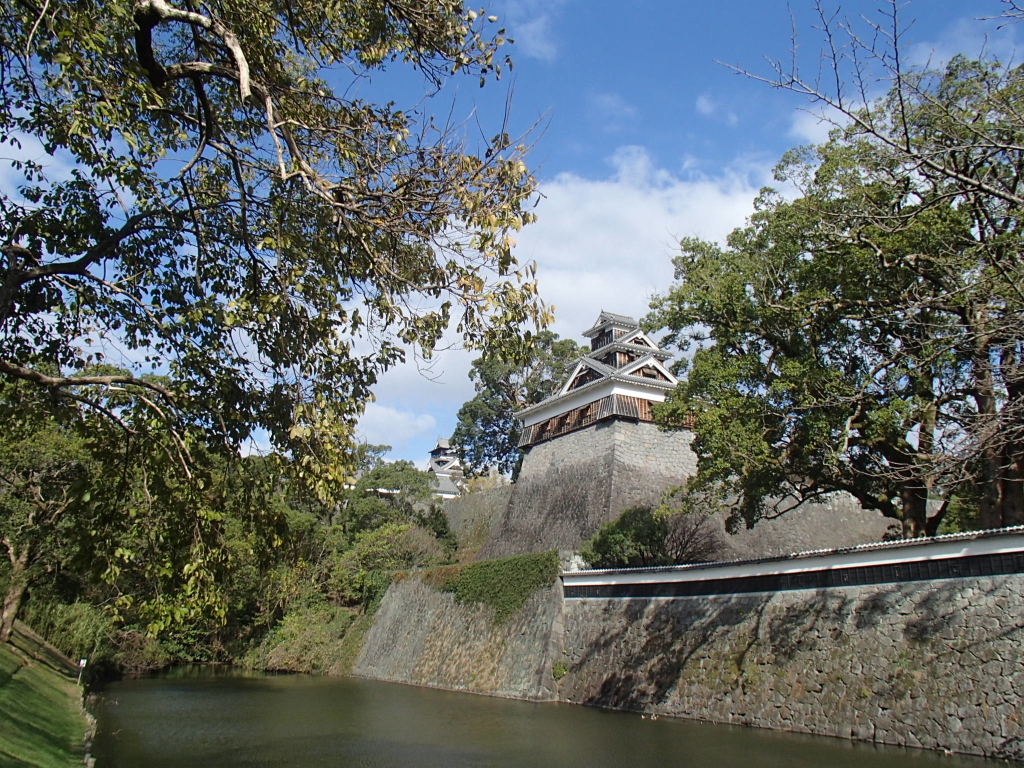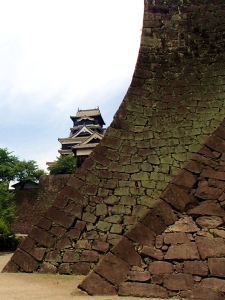Kumamoto castle suffered severe damage in the earthquakes of April 14th and 16th, it is currently closed to visitors.
The mighty and impenetrable Kumamoto Castle has dominated and protected the city of Kumamoto for over 400 years. Recently ranked the top Japanese Castle to visit on Trip Advisor, Kumamoto Jo has long held the title of being one of the top 3 castles in Japan and is well worth a visit.
History & Design
 The castle is set in vast grounds, Lord Kato Kiyomasa, the architect and founder of Kumamoto Jo, located the castle to utilise the natural rivers and hills to form its natural defenses. The castle originally had a 9km long perimeter wall and boasted 3 castle keeps, 49 turrets, 18 turret gates and 29 smaller gates. One of the most famed manmade defensive features of the castle are its technologically groundbreaking, beautiful, steeply curved ‘musha gaeshi’ walls, literally ‘Warrior Defense’. The walls are designed so that the base of the walls slope gently, almost inviting you to climb up but then curve perpendicularly, so that any samurai climbing up would easily be picked off or simply fall off. Anyone who succeeded in scaling the walls would then meet the ‘Shinobi gaeshi’ or Ninja Defense, a set of long metal skewers extruding from the tops of the walls. Inside the castle a variety of cunning defences were installed to help repel and slow down any intruder, nightingale floors, hidden steps and sudden low doorways plus an almost mazelike set of entrance ways and gates surrounded by high walls with a multitude of arrow slits and grates for dropping things on the enemy.
The castle is set in vast grounds, Lord Kato Kiyomasa, the architect and founder of Kumamoto Jo, located the castle to utilise the natural rivers and hills to form its natural defenses. The castle originally had a 9km long perimeter wall and boasted 3 castle keeps, 49 turrets, 18 turret gates and 29 smaller gates. One of the most famed manmade defensive features of the castle are its technologically groundbreaking, beautiful, steeply curved ‘musha gaeshi’ walls, literally ‘Warrior Defense’. The walls are designed so that the base of the walls slope gently, almost inviting you to climb up but then curve perpendicularly, so that any samurai climbing up would easily be picked off or simply fall off. Anyone who succeeded in scaling the walls would then meet the ‘Shinobi gaeshi’ or Ninja Defense, a set of long metal skewers extruding from the tops of the walls. Inside the castle a variety of cunning defences were installed to help repel and slow down any intruder, nightingale floors, hidden steps and sudden low doorways plus an almost mazelike set of entrance ways and gates surrounded by high walls with a multitude of arrow slits and grates for dropping things on the enemy.
Kato Kiyomasa knew all too well what seige conditions were like due to almost starving to death while holed up in a castle for months during Japan’s Korean War waiting for reinforcements. In order to survive a lengthy seige he had 120 wells situated within the castle grounds, he also ingeniously used edible tatami mats as flooring and secreted a variety of dried food stocks inside the castle walls for emergency use.
Even friendly visits to the castle were not without their challenges as everyone had to pass through the Kuragari-Tsuro to reach the Grand Palace and Castle Towers. Possibly Kiyomasa’s most dramatic and unique architectural feature, the Kuraguri-Tsuro is literally the ‘Dark Corridor’ an eery underground passageway leading to the palace entrance. Even today with electric lighting the atmosphere of the passage feels grandly intimidating, lit by fire and heavily guarded one can only wonder what psychological impression it had on visitors. A secret passage from the palace leads directly to the Lord’s subterranean entrance allowing the Lord to make a speedy entrance or secret exit as desired.
The castle was built between 1601 and 1607, a Ginko tree was planted in front of the main castle tower by Kiyomasa to celebrate its completion . Famously a fortune teller warned Kiyomasa that if the tree were to grow as tall as the castle tower the castle would be in peril. This may indeed have come to pass as in February 1877, three days before the start of the Seinan Civil War and Kumamoto Castle’s one and only seige, a mysterious fire burnt the majority of the castle to the ground. The Ginko tree was badly burnt and lost its upper portion, so we will never know its height at that time, however the tree still survives and continues to grow.
The restoration
 In 1960 the main castle towers were rebuilt in their original state, the interior was made into the present day castle museum. Though there is little explanation of the exhibits in English the view from both towers is worth all the stairs.
In 1960 the main castle towers were rebuilt in their original state, the interior was made into the present day castle museum. Though there is little explanation of the exhibits in English the view from both towers is worth all the stairs.
Much more recently in 2008 the Honmaru Goten Palace was restored to commemorate the castle’s 400th anniversary. the reconstruction is based on historical records and used traditional materials and building techniques, the highlight is the beautiful Shokun Hall with its stunning gold leaf wall and ceiling murals.
Travel Tips:
The castle has a simple information leaflet in English, Chinese or Korean. However, to get the most out of your visit to the castle hiring a guide is recommended. Guided tours are offered at set times throughout the day around the castle though most guides are Japanese speakers only. To find out more about booking a private tour of the Castle with an English speaking guide click here.
Various events are held at the castle throughout the year, with dance, theatre, taiko drumming, yabusame, live music and the stunning festival of light when thousands of flickering bamboo lights decorate the castle grounds. Kumamoto castle is also one of the best places to view Japan’s famous cherry blossom. From the end of March to early April the castle opens late to allow night time sakura viewing.
Behind the castle you will find a large, beautifully grassy and flat park called Ninomaru Koen, here Kumamoto locals often gather to spend a relaxing afternoon under the shade of the large trees. On the far side of the park is Kumamoto’s Prefectural Art Gallery, and a short walk away you will find the Gyobutei Mansion, a restored Samurai Mansion House with beautiful, traditional gardens.
Getting there:
If you don’t fancy the rather steep and winding walk up to the castle from the city centre catch the free shuttle bus from in front of Sakurababa Jousaien which will take you up to the Hohoategomon Gate by Ninomaru Park. It runs every 7 minutes and only takes 3 minutes.
From Kumamoto Station, just jump on a streetcar heading towards the city centre and get off at the Kumamoto Castle stop. It will cost 150 Yen one way for adults and 80 Yen for school age children.
Opening Hours: March – Nov 08:30〜18:30, Dec – Feb 08:30〜17:30
Closed: Dec 29th to 31st
Entrance fee: Adults and high school students 500 yen, elementary and junior high school students 200 yen, 20% off for groups of 30 or more.


